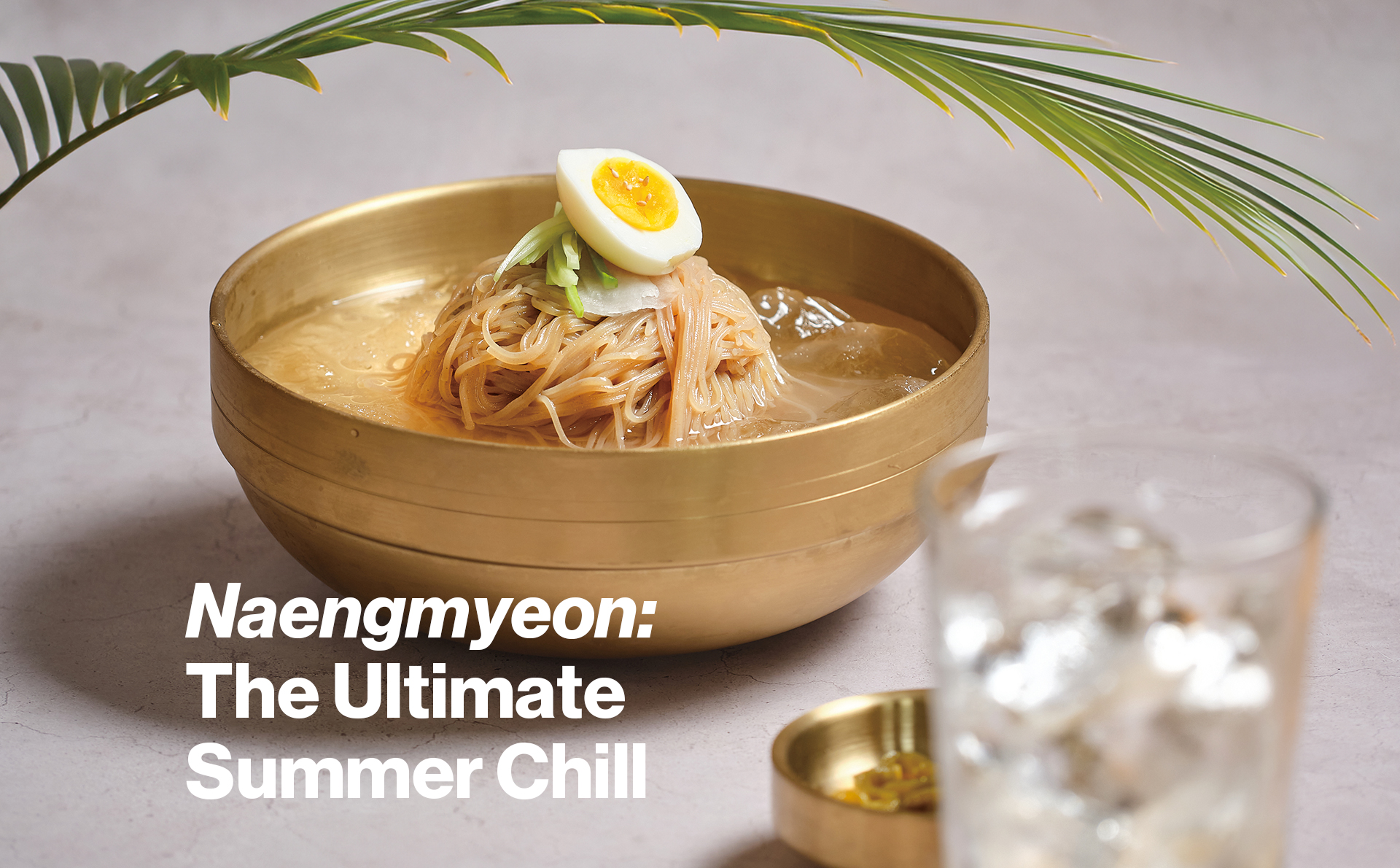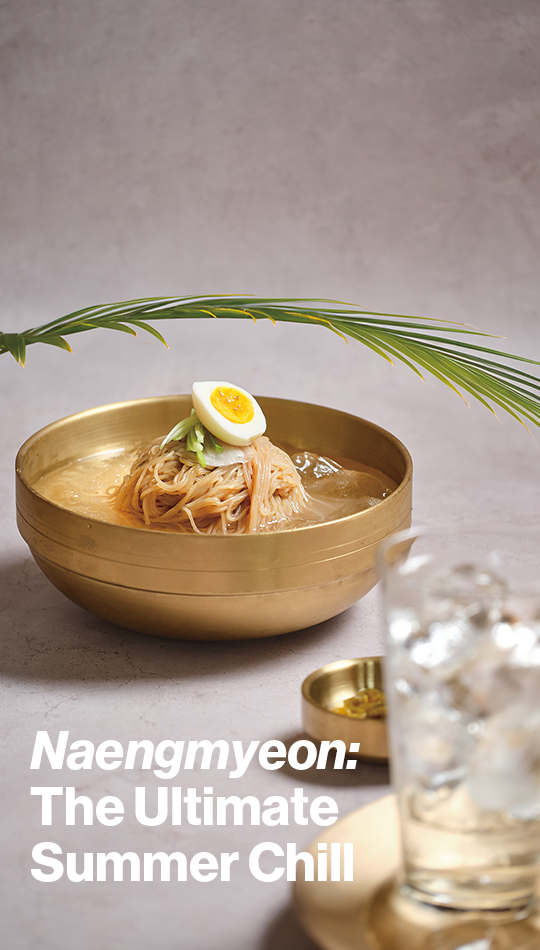Can a dish completely change your mood with just one bowl? For Koreans, such a dish exists―it’s none other than naengmyeon (cold buckwheat noodles), a culinary delight particularly enjoyed during scorching summer days. It acts as a powerful energizer, swiftly cooling the body’s heat and replenishing energy in a single gulp, leaving you feeling rejuvenated and cool.


Writer. Jang Heejoo
Winter Staple Turned Summer Delight
As July rolls in, Korea plunges into the full swing of summer. The air hangs heavy with moisture, the sun beats down relentlessly, and everyone’s looking for something refreshing. Around this time, as you stroll through the streets lined with restaurants, you’ll notice a particular buzz around certain establishments. They’re the ones serving up cold noodles―naengmyeon restaurants.
Naengmyeon consists of freshly made noodles served in cold broth―a dish beloved by Koreans year-round but especially popular in the summer―with its savory meat broth, chewy noodles, tangy vinegar and optionally spicy-sweet seasoning sauce tantalizing the taste buds upon the first bite, both cooling down the body temperature and stimulating the palate.
The dish, naengmyeon, which perfectly suits summer, wasn’t originally a summer delicacy; it was a winter staple from the northern regions―due to the seasonal cultivation of buckwheat and other ingredients in autumn and the challenges of ingredient preservation, components like noodles, dongchimi (radish water kimchi), broth and toppings couldn’t be kept fresh during the summer months.
The transition of naengmyeon from a winter dish to a summer icon unfolded due to historical events; naengmyeon, primarily consumed in the north, spread throughout the Korean peninsula due to people fleeing to the south during the Korean War. After that, technological advancements facilitated easier food preservation, making naengmyeon available year-round instead of just in winter―given Korea’s sweltering summers, refreshing naengmyeon naturally became more beloved during the season.
Naengmyeon with a Regional Twist
Naengmyeon, spreading across the nation, has adopted regional characteristics, with distinct differences in broth, seasoning, noodles and toppings―let’s delve into the renowned naengmyeon varieties from different regions.
Starting in Seoul, pyeongyangnaengmyeon (Pyeongyang cold buckwheat noodles), originating from Pyeongyang, is famous―featuring a refreshing taste with its beef broth and dongchimi broth, and toppings typically include beef, while the noodles, made from buckwheat, are pleasantly tender.
Moving east from Seoul, in Yangpyeong, pork broth replaces beef broth in naengmyeon, originally using pheasant, scarcity led to the use of common pork, resulting in thinly sliced pork toppings, and the noodles are thicker in this variation.
Heading towards the coast of Gangwon-do Province from Seoul, a different kind of naengmyeon awaits―here, hamheungnaengmyeon (Hamheung cold buckwheat noodles) takes the stage, featuring a spicy seasoning sauce made with gochujang (red chili paste), and the noodles, made from potato starch, provide a chewy texture, often served with raw fish, especially prevalent in Sokcho, with myeongtaehoe (raw pollock).
Further south, in Jinju, lies jinjunaengmyeon (Jinju cold buckwheat noodles)―a uniquely indigenous naengmyeon unaffected by northern influences. It is made with buckwheat noodles and seafood broth. What’s more, its toppings, unlike those from other regions, notably feature yukjeon (panfried battered beef), adding an extra touch of distinction.
Your Ultimate Satisfaction in a Bowl
Despite the distinctive regional flavors, these naengmyeon varieties enjoy nationwide fame, accessible in any region, and are often replicated in ready-to-eat meals―on particularly hot days when appetite wanes and the body feels weary, why not whip up some naengmyeon? Pre-chilled in the freezer, the slightly chilled and tangy broth, crisp summer vegetables and chewy noodles create a refreshing sensation that revitalizes both body and mind in an instant.
To elevate your meal further, consider preparing side dishes commonly enjoyed with naengmyeon by Koreans―wrap some bulgogi with naengmyeon or enjoy plump mandu (dumplings) alongside. The combination of hot side dishes and cold main dish promises an unparalleled satisfaction that will leave you fully content.
Chogye Naengmyeon (Cold Chicken Buckwheat Noodles)
15 mins.
INGREDIENTS
2 packs chicken breasts, 1 spring onion, 1/4 onion, 1/4 cucumber, 1/2 bell pepper, radish, 1 pack naengmyeon noodles, 1 pack naengmyeon broth, ice cubes, 1/2 tablespoon sugar, 1 tablespoon vinegar, 1/2 tablespoon ganjang (soy sauce), 1 tablespoon mustard, a pinch of salt
- Boil chicken breast, spring onion and onion together, then mix naengmyeon broth and chicken broth in a ratio of 2:1.
- Thinly slice cucumber, radish, bell pepper, and lightly salt the radish. Shred the chicken breast.
- Mix sugar, vinegar, ganjang and mustard to make the sauce, then coat the shredded chicken breast with it.
- In a serving bowl, place boiled naengmyeon noodles, ice cubes and broth, and top with shredded chicken breast and thinly sliced vegetables.
Tomato Naengmyeon
10 mins.
INGREDIENTS
2 tomatoes (If small, use 3), 1/8 onion, 1/2 tablespoon gochujang (red chili paste), 1/2 tablespoon vinegar, 1 tablespoon sugar, 1/2 tablespoon minced garlic, 1/4 teaspoon salt, 1 boiled egg, naengmyeon broth, naengmyeon noodles, 1/4 cucumber
- Freeze the naengmyeon broth.
- Blend tomatoes, gochujang, onion, vinegar, sugar, minced garlic and salt in a blender.
- Slice cucumber and cut tomatoes into half-moon shapes for garnish.
- In a serving bowl, place boiled naengmyeon noodles, tomato sauce, cucumber and boiled egg, then pour in naengmyeon broth according to taste.
